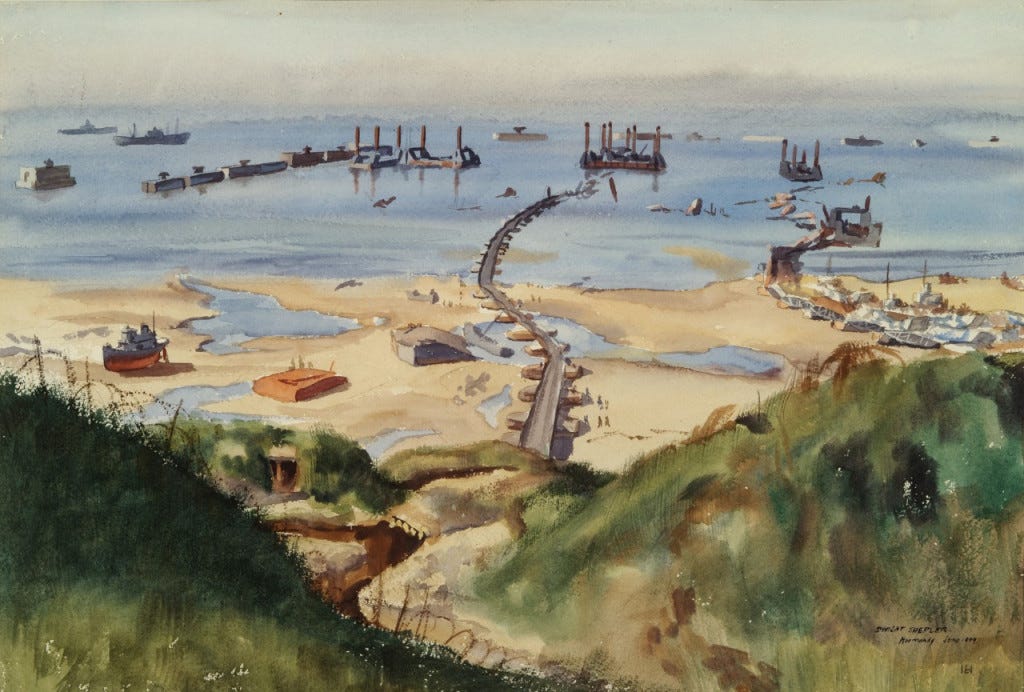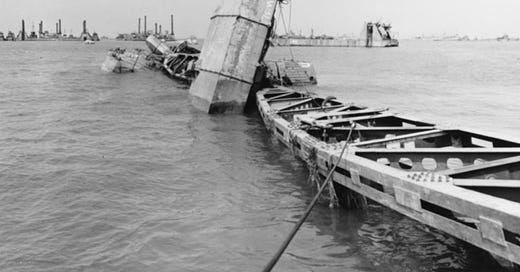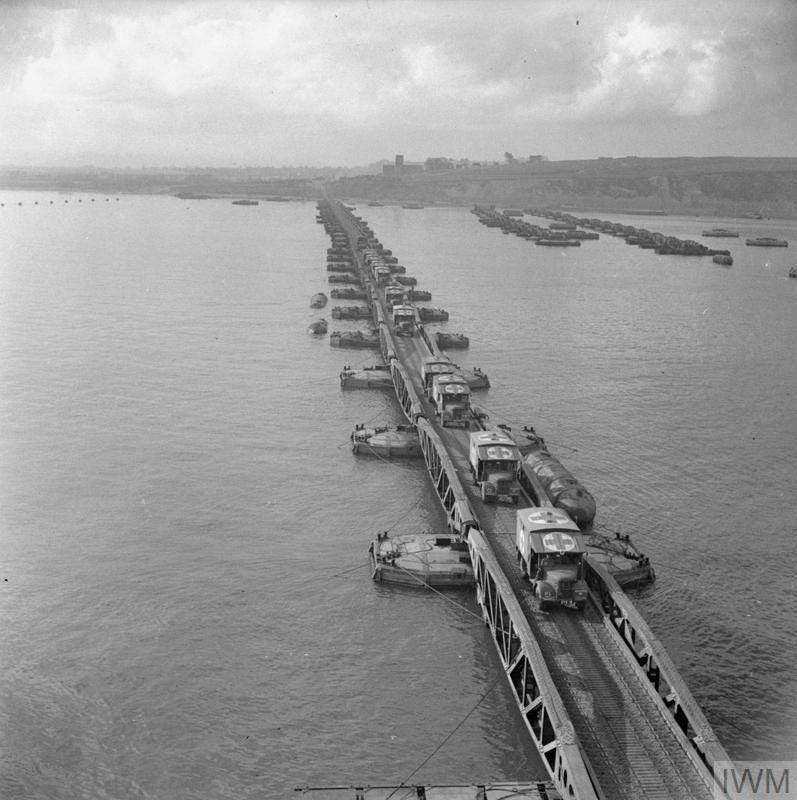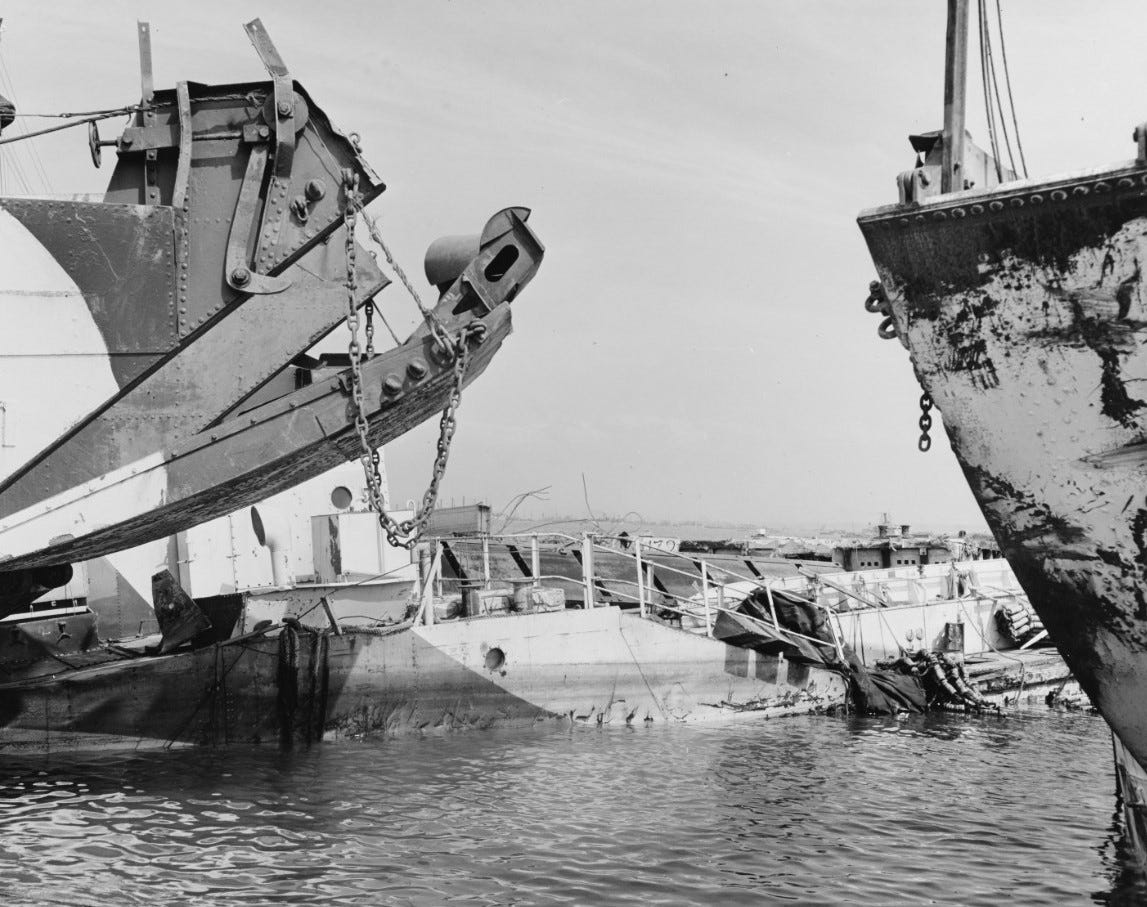D-Day: Keeping the Mulberry secret
By the time the worst storm system the English Channel had seen in years rolled in on June 19, 1944, correspondents and everyone else involved with the Normandy invasion had long been attuned to the importance of weather.
The fact that D-Day had been pushed back a day from June 5 due to poor weather was public knowledge shortly after the actual landings were made, and the correspondents covering the air war in particular had long been accustomed to how meteorology could affect operations on their beat.
So when a storm rolled through the Channel early on June 19, it merited a separate three-paragraph story of its own on the Associated Press wire:
LONDON, June 19 (AP) -- The wind rose swiftly in the Strait of Dover today and by noon was blowing a gale from the north-northeast, with gusts registering up to 60 miles an hour.
Conditions at sea, especially in midchannel, were extremely bad as the gale piled the sea into a mass of high, broken waves. There were occasional sunny intervals.
The wind was coming from one of the worst possible quarters for Allied unloading operations on the beaches of Normandy.
The main United Press story of the day included a paragraph on the conditions as well:
Rain and high winds provided a bleak setting for the Yanks' advance and Allied planes could not assist the ground forces by pounding enemy transport columns jamming the roads into Cherbourg. It was one of the worst spells of weather since D-Day, with gale winds of nearly 60 miles an hour whipping through the channel.
What the correspondents did not -- could not -- report that day or over the next few days as they continued to chronicle conditions on the invasion beaches was the impact the storm system had on one of the great engineering achievements of the operation.
By this point, nearly two weeks after the invasion troops first gained a foothold, the two artificial harbors conceived by the British as a temporary resupply measure until a permanent port became available were up and running. Code named "Mulberry," one sat off Gold Beach at Arromanches and the other off Omaha Beach at Saint-Laurent-sur-Mer.
While the former, later named "Port Winston" in honor of the prime minister, would remain active for months after the invasion, the Mulberry facilitating supplies to U.S. troops off Omaha Beach incurred significant damage in the June 19 storm. Most of the concrete caissons were wrecked and the harbor was abandoned, with undamaged components used to supplement and repair its counterpart at Arromanches.
Not that anyone back home was any the wiser, of course.
The Mulberries' existence was no secret to the correspondents on the scene. Quite the opposite, in fact. Military public relations departments had ensured the press was on the scene when the harbors were being assembled, teeing up a round of stories lauding Allied ingenuity. But it would be months before those stories would reach their intended audience.
Though the Germans were undoubtedly aware of what was happening nearly in real time once work on the piers began in earnest on June 9, censors would not release the correspondents' accounts until fall.
The first public mention of the engineering feat came in a story by United Press correspondent James McGlincy with a September 8 dateline from "Allied Naval Headquarters, London." The piece is clearly designed as pushback by naval officials annoyed that the army seemed to be getting all the credit for all that had transpired since D-Day. In it, McGlincy notes that naval vessels had seen action in the Channel "almost every night" since June 6, fending off "U-boats, aircraft, human torpedoes and explosive motorboats."
Several paragraphs into the story comes a mention of the navy's ongoing contributions to the ground war in Normandy:
While the armies battled to secure ports, the navy kept pouring men and munitions on to the beaches through temporary harbors. These harbors are of two types -- one made by sinking blockships, the other by building concrete piers.
It took a force of 2,000 to 3,000 craft and some 15,000 men to build artificial harbors on which work was begun D-Day plus one. They still are used extensively, although Cherbourg already is taking a great tonnage of vital supplies.
McGlincy's story appeared in a few newspapers in the day or two after it hit the wire, but, curiously, there was no follow-up and no more detail forthcoming for about five more weeks. That gap, and what followed it, suggest that perhaps the naval officials feeding McGlincy that day in September spoke without full authorization that the Mulberry details could be released to the press.
Because when they were, on October 16, the story got massive play across media outlets. The Associated Press piece from that announcement, which appeared on Page 1 of numerous papers, began this way:
Two artificial harbors, built in secret and towed across the channel behind the assault forces for installation on the Normandy beaches, supplied the invasion armies and "made possible the liberation of western Europe," supreme headquarters disclosed tonight.
From there, the story piled up detail after detail -- 150 concrete caissons were built, the largest displacing 6,044 tons; seven miles of prefabricated pier equipment; 20,000 British laborers to build the caissons alone; 85 tugs completing 500 tows to get the components from Britain to Normandy.
The story does note the storm's devastation of the Mulberry off Omaha (without using either of those words):
Everything went according to plan for 12 days and then a gale blew up -- the worst June gale experienced in 40 years. Tearing in from an exposed direction, the storm almost ruined the American harbor. Steel and concrete breakwaters weighing thousands of tons were tossed onto the beach.
The British port did not suffer so badly, however, and was soon completed.
With the official story now public, censors released the prewritten accounts compiled by correspondents who had witnessed the work months before: "We watched from Capt. (Augustus) Clarke's submarine Chase as the great concrete and steel structure was sunk into place by American tugboat crews," wrote W.R. Higginbotham and Everett Vilander of UP.
A few days later, UP moved a story out of Washington, D.C., bearing Rear Adm. Ben Morrell's byline. Morrell, chief of the U.S. Navy's civil engineers, described the concept and construction of the harbors and used the code name "Mulberry" in his lead paragraph.
While Morrell's account was technical, veteran Chicago Daily News foreign correspondent Robert J. Casey waxed poetic about the spectacle of the scuttled ships forming a breakwater around the Mulberries, "one of the most amazing engineering jobs that has come out of this or any other war":
Along the near skyline, nose to tail like elephants in a circus parade, ranges a long pageant of forgotten steamers. You wonder at them, used as you may be to all the ghostly resurrections that this invasion has evoked from the graveyard of ships. No smoke rises from their gray funnels, nor have they any motion as the riotous sea breaks against them.
Casey's tribute unfolds over hundreds of words, inviting you to "gaze across the calm blue water at the constant procession of heavily loaded trucks going forward into the green distances over a dozen dust-veiled roads."
At the end, he returns to his lead:
And the pageant of the sunken ships? As you look at all this you realize the purpose behind their sacrifice. ... And you feel a little less sorry for them. They are probably doing the most important work they have done since the bunting flew for their launching, here at the end of their final voyage.







